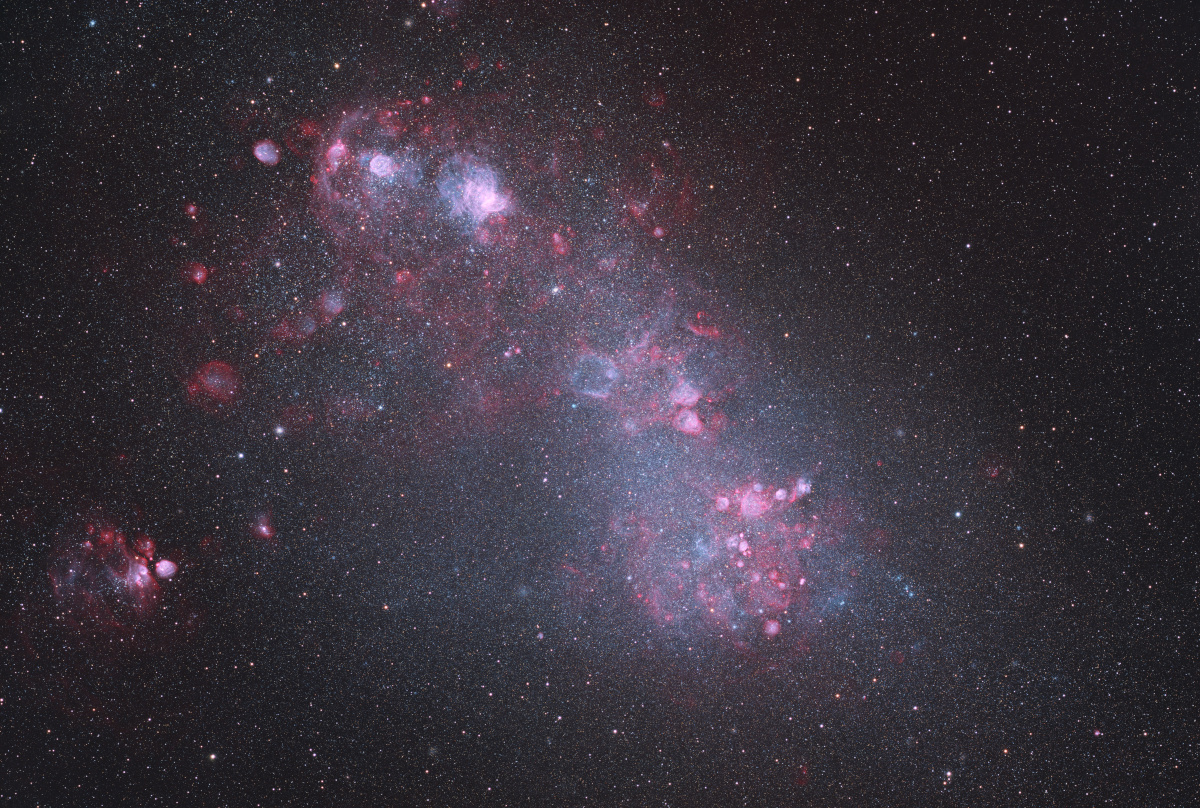
[back] NGC 292 (SMC, Small Magellanic Cloud) in Tucana [NED]
Big, slightly cropped 100%
image version / Große, leicht beschnittene 100% Bild-Version (9390 x 6323
pixel, 1.464"/pixel)
50% Starless
version (Ha,OIII,OIII
4695 x 3162 pixel)

|
(c) 2023 All astro photo images are copyrighted. They may not be used or reproduced without explicit written permission from the authors. |
|
0.5 degree |
|
About this Image / Über dieses Bild
| Camera: | Moravian C3-PRO-61000 Mono CMOS |
| Image Type, Orientation: | L-R+Ha,G+OIII,B+OIII Composite, North is at 12:00 |
| Exposure time: | L: 62*120s, R,G,B: 20x120s, Ha: 76x300s, OIII: 104*300s (19:04h total), unguided |
| Exposure date: | June 15th..23rd, 2023 |
| Location: | Capella Observatory South at Kiripotib Astro Farm, Namibia, remote-controlled from Heroldsbach/Germany |
| Filter: | Astronomik Deep-Sky Deep-Sky RGB Filter set and 6nm SII, Ha, OIII filters on Moravian EFW-3L-9-II External Filter Wheel |
| Instrument: | "Callisto", a Takahashi FSQ 106N, 530mm focal length, 106mm aperture, f/5 on modified Losmandy G11 (high res encoders with OnStepX) |
| Photographer: | Rainer Raupach, Josef Pöpsel, Frank Sackenheim |
| Remarks: |
The Small Magellanic Cloud (SMC) is an irregular dwarf
galaxy in the constellation of Tucana and part of the Local Group. With a
diameter of approximately 7,000 light-years, it has a significantly smaller
size as well as mass than the Milky Way. It is located at a distance of
about 200,000 light-years from us, which is only about one-tenth the
distance to the Andromeda Galaxy. However, its gravitational binding to the
Milky Way is uncertain, due to its high tangential velocity of approximately
300 km/s. Therefore, there is a possibility that the SMC (and similarly, the
Large Magellanic Cloud) are merely passing by the Milky Way by chance. It is
also unclear whether the SMC and LMC are gravitationally bound to each
other, as they are moving away from each other at a high speed of
approximately 100 km/s. The question of gravitational binding depends mainly
on the actual masses of the two dwarf galaxies. Only if the masses were at
least twice as large as currently assumed, for example, due to dark matter,
there could be gravitational binding between them given these orbital
motions. The SMC is rich in emission regions. These are partially stimulated by young star clusters or are planetary nebulae or supernova remnants. In this deep image with nearly 20 hours of exposure time, the focus is on the emission nebulae that are visible in Ha or OIII emission. Many interesting structures emerge among the countless stars. BlurrXTerminator was used for the image (option "correct only") |
|
|
|
| Bemerkungen: |
Die Kleine Magellansche Wolke
(SMC) ist irreguläre Zwerggalaxie im Sternbild Tukan und Teil der lokalen
Gruppe. Sie hat mit einem Durchmesser von etwa 7000 Lichtjahren erheblich
weniger Größe sowie Masse als die Milchstraße. Ihre Entfernung zu uns
beträgt etwa 200000 Lichtjahre, d.h. nur ca. ein Zehntel der Entfernung der
Andromeda-Galaxie. Tatsächlich ist aber eine gravitative Bindung an die
Milchstraße ungeklärt, was mit der hohen Tangentialgeschwindigkeit von ~300
km/s begründet ist. Es besteht also die Möglichkeit, dass die SMC (und mit
gleicher Begründung auch die LMC) nur zufällig an der Milchstraße
vorbeiziehen. Ebenso ist unklar, ob SMC und LMC untereinander gebunden sind,
da diese sich mit ~100 km/s voneinander entfernen. Die Frage nach der
gravitativen Bindung hängt vor allem von den tatsächlichen Massen der beiden
Zwerggalaxien ab. Nur wenn die Massen mindestens doppelt so groß wie bisher
angenommen wären, z.B. durch dunkle Materie, könnte eine Bindung bei diesen
Eigenbewegungen vorliegen.
Das Bild wurde mit dem BlurrXTerminator bearbeitet, wobei lediglich "correct only" verwendet wurde. |
Back to the Galaxies' Overview / Zurück zur Galaxien-Übersichtsseite